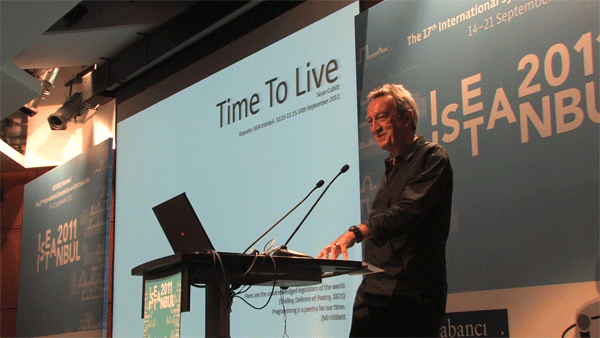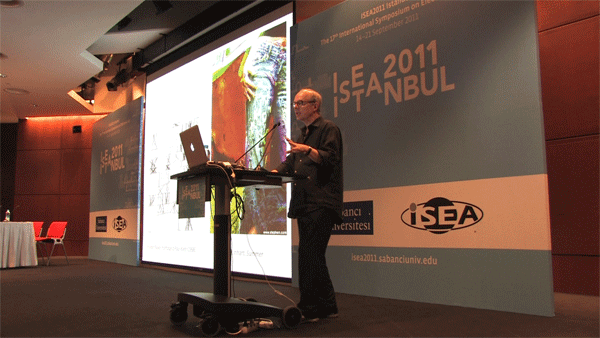

The 12th Istanbul Biennial and ISEA 2011 coincided this year, resulting in a jam-packed week of activity. At any hour of the day, there was a dizzying array of talks, performances, exhibitions, and art openings across the city of Istanbul. Organizing two high profile, international art events at the same time was a wise choice, as it produced an element of synergy between them. The biennial exhibition was especially attentive to the Arab Spring, and the effect this has had in the region, while ISEA was more oriented to the problems and future possibilities of technology. Taking in both the biennial and ISEA in the same week lead me to think about the power of technology, and its significance for both established and emerging democracies.
ISEA kicked off with a keynote entitled “Time to Live” by the writer and academic Sean Cubitt. Taking its title from the TTL mechanism used in the movement of data across a network or computer, Cubitt argued that the struggle over space and time is a defining aspect of digital media, and ultimately, that time becomes alienated in liaison with new technologies. Time, for him, was once a humanistic force, but has now become something that is used over and against humanity through its instrumentalization. In order to chart the progressive alienation of time, Cubitt points to the development of three forms of media that he sees as dominant beginning in the 20th century — spreadsheets, databases, and geographical information systems. These forms have fundamentally altered the use and understanding of both time and space, resulting in their management and optimization towards biopolitical ends. The grid is the organizational method used across spreadsheets, databases, and geographical information systems, and in the closing section of his talk, Cubitt offered the vector as an oppositional form capable of suggesting new alternatives to the grid. In order to unearth differing structures such as the vector, Cubitt urged artists and researchers alike to go back and revisit earlier, obsolete technologies and practices with a fresh eye.
 Sean Cubitt's Lecture "Time to Live" at ISEA 2011 (Photo Credit: Barbaros Gokdemir)
Sean Cubitt's Lecture "Time to Live" at ISEA 2011 (Photo Credit: Barbaros Gokdemir)
I had Cubitt’s call to re-examine history for new solutions at the back of my mind when I visited the Istanbul Biennial, as the show’s unique premise, organized around the work of Felix Gonzalez-Torres, seemed to similarly dig into the past in order to find pressing correspondences with the present. Curated by Jens Hoffman and Adriano Pedrosa, the exhibition spread across two large warehouses adjacent to the Istanbul Modern. The exhibition’s design, created by architect Ryue Nishizawa, was comprised of a maze-like series of various sized rooms without ceilings, whose entrances and exits emptied out into passageways. Corrugated metal covered the exterior walls of the rooms, giving it the semblance of a building or home. In the catalog, it was explained that the Nishizawa had intended to mimic Istanbul’s intersecting streets and alleys. If anything, the layout allowed for an overlapping exchange between the wide range of subjects explored in the show, as each room was either grouped works around a theme from Gonzales-Torres’s oeuvre or presented work by an individual artist.
Such a loose overarching concept could risk dissolving into vague generalities or incoherent abstraction, but the 12th Istanbul Biennial was urgent, political, and hardhitting. Any worthwhile biennial must assess the moment in which it was organized, and one persistent thread I noticed was an attention towards the Arab Spring, perhaps the most important topic to emerge in the region within the past two years. At first glance, it might seem impressive, surprising even, that the curators were able to draw out so many connections between the concerns of Felix Gonzalez-Torres, whose work was fully seeped in the context of 1980s New York and his own personal biography as a queer, HIV positive, Cuban/Puerto Rican artist, and the liberation movements in the Middle East. However, the commonalities seemed to substantiate a point made by Slavoj Zizek on Al Jazeera right after the protests in Cairo, that the movement in Egypt was evidence of a universal desire for freedom, one that crosses all cultural barriers. Perhaps it is this universality that allowed Gonzalez-Torres’s artworks to speak so readily to some of the charged topics in the exhibition.
Of the many rooms located within the warehouse buildings, two in particular stood out to me, “Untitled (Death by Gun)” and “Untitled (History).” “Untitled (Death by Gun)” centered around Gonzalez-Torres’s specific work Untitled (Death by Gun) while “Untitled (History)” was inspired by Gonzalez-Torres’s series of dateline pieces. The original work Untitled (Death by Gun) by Gonzalez-Torres was a stack of single sided posters given to visitors freely which displayed the faces and descriptions of 460 victims of gun violence, who died between May 1-7, 1989. The room was a meditation on guns and violence, and it began with a partial photographic history of their destructive power by the likes of Weegee, Mathew Brady, and Eddie Adams. Iconic photos, such as Adams’s Street Execution of a Viet Cong Prisoner, Saigon (1968), depicted disturbing images of dead bodies lost to crime and warfare. Other works in this section addressed the fetishization of the gun and its relationship to authority. Akram Zaatari’s Hashem el Madani: Studio Practices (2007) collected photos from the fifty year archive of Lebanese professional studio photographer Hashem el Madani, whose subjects, the everyday men and women of the town Saida, playfully posed with guns. Within el Madani’s studio, the guns seem safe, a simple prop, whereas outside, they were a source of fear. Kris Martin similarly recontextualizes the gun in his sculpture Obussen II (2010) that assembles 700 empty Howitzer shells used in WWI into a large pile. Gleaming and gold, they seem magnificent and regal, until one recognizes what they were and how they were used.

Kris Martin, Obussen II, 2010 (Photo Credit:Nathalie Barki)
Intersecting “Untitled (Death by Gun)” was an individual artist presentation by Bisan Abu-Eisheh, which expanded the lens to military violence on a whole, through his installation Bayat Bayoot “Playing House” (2008-2011). In a series of vitrines, Abu-Eisheh catalogued detritus collected from houses destroyed in the Palestinian neighborhoods of Jerusalem by the Israeli government. Toys, plumbing, utensils, CDs, clothing, and bits of furniture are neatly displayed under the glass, along with the location it came from, the date of the demolition, and the number of people who inhabited the house. The vitrines were accompanied by a looped video of the destruction of a five-story building in the Palestinian district of Beit Hanina, which the artist sourced from YouTube. Abu-Eisheh’s move to clinically organize artifacts resulting from terrible devastation, discrimination and violence, in order to provoke horror and sympathy reminded me of Gonzalez-Torres’s Untitled (Death by Gun). Both works seem to recoup the bureaucratic methods used to manage, track, and control human populations against their inherent indifference, by turning them into tools that present the humanity of their subjects.

Bisan Abu-Eisheh, Bayat Bayoot "Playing House", 2008-2011 (Photo Credit: Nathalie Barki)
“Untitled (History)” similarly turned a critical eye on bureaucracy, especially toward the medium of paper and its close relation to the establishment of the historical record. The room was loosely based around Gonzalez-Torres’s series of untitled dateline works, where the artist wrote the names of celebrities, events or products alongside the years of their occurrence (such as “Vietnam,” “Bruce Lee,” or “Waterbeds”). Julieta Aranda’s There Has Been a Miscalculation (Flattened Ammunition) (2007/2011) noisily occupied the center of the space. A large glass cube containing pulverized books on 20th-century history, every few seconds a computerized air compressor would blow its dusty contents around its interior. The pages of books were appropriated in the work of Simryn Gill as well, whose series Pearls took the sheets of Jorge Luis Borges’s Ficciones (1944) and Guy Debord’s La Société du Spectacle (1967) and made them into large beads strung onto a necklace. The mania of processing documents was aptly captured by Ali Kazma’s O.K. (2010), a seven channel video installation which showed an anonymous government official feverishly stamping papers. Paper, in this section, symbolized the oppressive weight of history, and its ties to the production of power. The works themselves suggested ways around its authority, often through fragmentation and reordering. Overall, the topic of resistance was something that fed through almost all of the rooms.

Julieta Aranda, There Has Been a Miscalculation (Flattened Ammunition), 2007/2011
(Photography: Natalie Barki)
Sometimes this was taken up quite literally, as in Homayoun Askari Siziri’s sculpture that spelled “revolution” in Farsi in one long metal loop, which, when traced by the viewer with a connected metal bar, would set of an alarm and a red light. (The piece was named after a quote from Jean Baudrillard, They (masses) absorb all the electricity of the social and political and neutralize it forever, 2008) Or, more subtly, as with Zarouhie Abdalian’s Having Been Held Under the Sway (2011) a site-specific sound installation with embedded bass speakers, whose low tones would continually shake the walls of the room. A single plumb bob hung down from the ceiling by a string, with a square metal plate placed above it. The vibrating walls would rattle the plate, moving the string and plumb bob. In response to a question about the political dimension of his work posed by Jens Hoffman in the exhibition catalog, Abdalian states, “Art strikes me as a weak tool for effecting political change. On the other hand, I often want my work to initiate a kind of epistemological rift. A successful work might act a bit like a speed bump: it may not change your path, but it registers, and for a moment, you move differently. Perhaps this strikes you as a pathetic image, but I believe there is a value in subtle disruptions initiated by artworks. They have the ability to quietly suggest a changed or altered perspective.” (87) In an area of the world that is currently undergoing massive political changes and unrest, this message of resistance, whether in the form of speed bumps or explicit exclamations of revolution, was clear.
Homayoun Askari Siziri, They (masses) absorb all the electricity of the social and political and neutralize it forever, 2008
(Photo Credit: Ceci Moss)

Zarouhie Abdalian, Having Been Held Under the Sway, 2011 (Photo Credit: Flickr user onlyanel)
The promise – and pitfalls – of history also seemed to be a fixation across town at ISEA. Media historian Oliver Grau’s keynote, “Media Art Explores Image Histories: New Tools for Our Field” envisioned an overarching, international database of new media art, which would cut across individual institutional repositories and initiatives, whose operation would be akin to large-scale scientific databases, such as those used in astronomy and climate science. New media art has been notoriously difficult to conserve, and such a notion does seem promising, especially for future study of new media art. Inspired by his own research on imaging technologies, Grau even postulated that such a database could additionally encompass a history of image-making technologies as a correlate to the new media art entries. The promises of software, and its relationship to the formation and understanding of history, were subjects also at play in MIT professor William Uricchio’s keynote, “Towards a New Order: the Algorithmic Turn.” In his talk, Uricchio argued that history could be more or less divided into two paradigms, the algorismic and the algorithmic. The algorism is a decimal system of numeration that requires precise reckoning and fixed rules, whereas the algorithm is a program, or a finite rule set that remains agnostic to what is plugged into it. According to Uricchio, the algorithm doesn’t take off as an active concept until the 20th century, and it presents a new orientation between subject and object, as well as the world at large. Algorisms were concerned with a precise subject-object relation, realized in things such as authorship and three-point perspective. On the other hand, the algorithm challenges a binary object-subject relation, and with it, attribution and point of view, as algorithms operate between the producing subject and the object that is produced. His examples of an algorithmic practice included Photosynth and Wikipedia – examples that contain a combined, collective authorship mediated by software. Uricchio sees the current moment as a transitional one between the algorismic and the algorithmic, ending his speech with musings about the possibilities of algorithmic logic, especially in connection with increasing quantities of data and new tools for analysis. Uricchio’s call to understand an algorithmic paradigm echoed with the panel organized by Kris Paulsen and Meredith Hoy scheduled two days before, entitled “Arabesque, Mandala, Algorithm: A Long History of Generative Art.” The papers explored a history of artworks, particularly moving images, produced by computational algorithms, a history that involves not only the contemporary computer, but also weaving looms and analog computers. The papers, which focused (broadly) on Stephen Beck’s video synthesizers (Kris Paulsen), John and James Whitney’s experimental animations made with analog computers (Zabet Patterson), computational abstraction (Meredith Hoy), and 17th-century Caucasian carpets (Laura Marks), revealed how algorithms are not abstract entities, but something realized within material conditions, which have repercussions for perception and visual experience. As Laura Marks pointed out in her talk, “Sensation and Individuation in Generative Artworks and Caucasian Carpets,” algorithms can also model life, and, in doing so, they involve assumptions about how change is achieved within those models. The panel persuasively uncovered algorithmic logic as it relates to aesthetic questions, and if algorithms are responsible for unsettling subject/object relations as Uricchio argued, then it seems that there is even greater urgency for this kind of research.

William Uricchio's Lecture "Towards a New Order: the Algorithmic Turn" at ISEA 2011 (Photo Credit: Barbaros Gokdemir)
Between ISEA and the Istanbul Biennial, so much ground was covered. History, as already elaborated, was one dominant theme, but other subjects crisscrossed between the two events, such as mapping and identity. In the future, I hope more major events like this overlap, as it allows for interesting parallels and dialogue.


